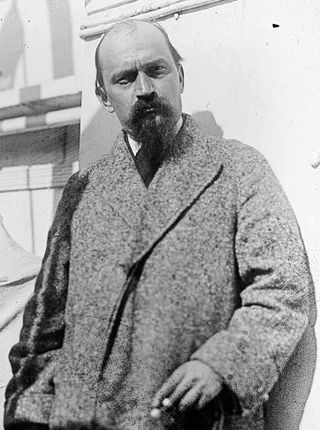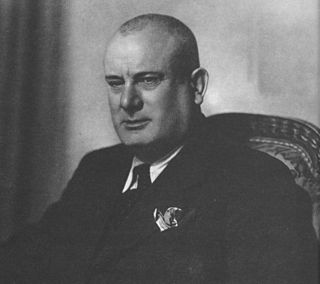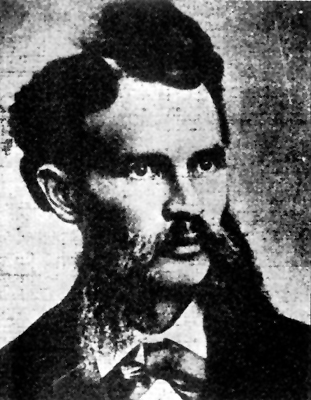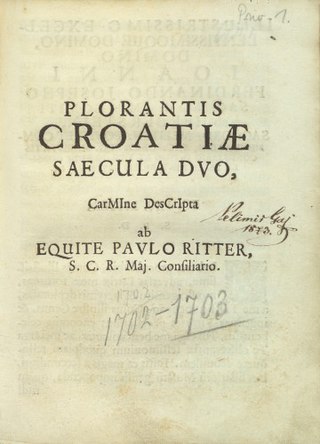
Mother Croatia (Croatian : Mati Hrvatska) is the female personification of Croatia and a national emblem of the nation.

Mother Croatia (Croatian : Mati Hrvatska) is the female personification of Croatia and a national emblem of the nation.
The nation of Croatia has historically been portrayed as a motherland, and is often personified as a female figure evoking the traditional woman's role as a mother and nurturer. [1] During the Illyrian movement in the 19th century, many prominent writers and intellectuals used the figure of Mother Croatia to represent the Croat people, especially in favor of nationhood and against Hungarian authority. Writer Mijo Krešić wrote in response to increasing Hungarian threat to the Croatian town Varaždin, "The Hun rejoices, but Mother Croatia laments!" [2]
The phrase has come up in the Croatian Parliament in a way of describing the nation. Once in a speech by Matija Mrazović in 1861 concerning the struggle against Hungarian hegemony, "That Mother Croatia did not accidentally birth a son, who would in the Hungarian Parliament deny her any independence" (Da hrvatska majka nije po nesreći rodila sina, koji joj je na Ugarskom saboru zaniekao svaku samostalnost). [3] Another time in June 1891, Dr. Milan Amruš spoke of the country, "Mother Croatia is a healthy and energetic mother" (Majka hrvatska je zdrava i čila majka). [4]

Croatian sculptor Ivan Rendić created several pieces depicting Mother Croatia. One is the tomb of Petar Preradović, which depicts a young woman (representing Mother Croatia) looking solemnly down at his final resting place as she lays her flowers on top. The monument (originally the idea of Croatian writer Franjo Marković), was unveiled on 14 July 1879 to much patriotic fanfare. [5] Another piece by Rendić is the statue of Ante Starčević in front of St. Mirko's Church in Zagreb. [6] At the base of the statue is a woman (the personification of Croatia) dressed as a warrior, with clenched fists and a defiant face, her gaze fixed ahead.
In painter Ferdo Quiquerez's Antemurale Christianitatis ("Bulwark of Christendom"), Croatia is portrayed as a woman holding a sword and a shield in the form of the Croatian coat of arms. She stands at the entrance of Europe and guards it from the Ottoman Turks. Behind her, the Dome of St. Peter's Basilica stands as a symbol Christianity, with noted figures such as Galileo Galilei and Dante Alighieri representing Western civilisation. Croatian-American artist Maksimilijan Vanka also painted Croatia as a mother for several murals inside St. Nicholas Croatian Church near Pittsburgh. [7]
One of Ivan Meštrović's most well-known works, the "History of the Croats", depicts a woman dressed in traditional Croatian dress from the Dalmatian hinterland, holding a large volume of work in her lap with Glagolitic text inscribed in the front. The woman (whose likeness is thought to be of Meštrović's own mother), portrays Croatia as a traditional matriarch and guardian of the nation's heritage and history. [8] Two copies of this statue exist, one in Zagreb, Croatia, and the other in the Royal Compound of Belgrade, Serbia.
Spomenik Neznanom junaku (Monument to the Unknown Hero), designed by Ivan Meštrović and main engineer Stevan Živanović, was unveiled in 28 June, 1938, ordered by King Alexander I Karađorđević to commemorate the victims of the Balkan Wars (1912–1913) and World War I (1914-1918). The sarcophagus is surrounded by caryatids representing all the peoples of the Kingdom of Yugoslavia. They represent Bosnian, Montenegrin, Dalmatian, Croatian, Slovenian, Vojvodina’s, Serbian and South Serbian women, symbolic mothers of the fallen sons from the wars. The monument was also euphemistically called "Altar of the Motherland". The Croatian woman shares a similar design with Meštrović's earlier work depicting the personification of Croatia.
The Illyrian movement brought many poems and songs to the forefront of the Croatian national revival. Many poems referencing Mother Croatia were published in periodicals and literary magazines.
Clergyman and politician Franjo Rački wrote a short biography of the 15th century nobleman and bishop Šimun Kožičić Benja in 1861, where he described him being "born to a grieving Mother Croatia" (...porodi žalostna majka hrvatska.) [9]
Poet Silvije Strahimir Kranjčević published the poem "Hrvatskoj Majci" in his book Bugarkinje (1885). [10]
In 1882 Hugo Badalić wrote a poem for the opening of the Đakovo Cathedral in eastern Croatia, in which he proclaims, "Rejoice, O Mother Croatia!" [11]
August Harambašić released a collection of patriotic songs poems in 1895, which include references to Croatia as a Mother to her people. [12]

Ivan Meštrović was a Croatian and Yugoslav sculptor, architect, and writer. He was the most prominent modern Croatian sculptor and a leading artistic personality in contemporary Zagreb. He studied at Pavle Bilinić's Stone Workshop in Split and at the Academy of Fine Arts Vienna, where he was formed under the influence of the Secession. He traveled throughout Europe and studied the works of ancient and Renaissance masters, especially Michelangelo, and French sculptors Auguste Rodin, Antoine Bourdelle and Aristide Maillol. He was the initiator of the national-romantic group Medulić. During the First World War, he lived in emigration. After the war, he returned to Croatia and began a long and fruitful period of sculpture and pedagogical work. In 1942 he emigrated to Italy, in 1943 to Switzerland and in 1947 to the United States. He was a professor of sculpture at the Syracuse University and from 1955 at the University of Notre Dame in South Bend, Indiana.

Augustin Josip "Tin" Ujević was a Croatian poet, considered by many to be the greatest poet in 20th century Croatian literature.

Večernji list is a Croatian daily newspaper published in Zagreb.

Petar Preradović was a Croatian poet, writer, and military general. He was one of the most important Croatian poets of the 19th century Illyrian movement and the main representative of romanticism in Croatia.

The Kingdom of Croatia-Slavonia was a nominally autonomous kingdom and constitutionally defined separate political nation within the Austro-Hungarian Empire. It was created in 1868 by merging the kingdoms of Croatia and Slavonia following the Croatian–Hungarian Settlement of 1868. It was associated with the Kingdom of Hungary within the dual Austro-Hungarian state, being within the Lands of the Crown of St. Stephen, also known as Transleithania. While Croatia had been granted a wide internal autonomy with "national features", in reality, Croatian control over key issues such as tax and military issues was minimal and hampered by Hungary. It was internally officially referred to as the Triune Kingdom of Croatia, Slavonia and Dalmatia, also simply known as the Triune Kingdom, and had claims on Dalmatia, which was administered separately by the Austrian Cisleithania. The city of Rijeka, following a disputed section in the 1868 Settlement known as the Rijeka Addendum, became a corpus separatum and was legally owned by Hungary, but administered by both Croatia and Hungary.

Ivo Pilar was a Croatian historian, politician, publicist and lawyer, considered the father of Croatian geopolitics. His book The South Slav Question is a seminal work on the South Slav geopolitical issues.
Biskupija is a village and municipality in Šibenik-Knin County, Croatia. The seat of the municipality is the village of Orlić.

Mate Meštrović, also known as Matthew Mestrovic, is a Croatian American journalist, lobbyist, politician and ambassador.

Hugo Badalić was a Croatian writer.

The Kosovo Maiden or Maiden of the Blackbird's Field is the central figure of a poem with the same name, part of the Kosovo cycle in the Serbian epic poetry. In it, a young beauty searches the battlefield for her betrothed fiancé and helps wounded Serbian warriors with water, wine and bread after the Battle of Kosovo in 1389 between Serbia and the Ottoman Empire. She finally finds the wounded and dying warrior Pavle Orlović who tells her that her fiancé Milan Toplica and his blood-brothers Miloš Obilić and Ivan Kosančić are dead. Before the battle they had given her a cloak, golden ring and veil for the wedding as a promise of safe return, but they were slain and Pavle pointed to the direction of the bodies. The poem finishes with:
"O wretch! Evil is your fortune!
If I, a wretch, were to grasp a green pine,
Even the green pine would wither."
Croatian literature refers to literary works attributed to the medieval and modern culture of the Croats, Croatia, and Croatian. Besides the modern language whose shape and orthography were standardized in the late 19th century, it also covers the oldest works produced within the modern borders of Croatia, written in Church Slavonic and Medieval Latin, as well as vernacular works written in Čakavian and Kajkavian dialects.
István Blazsetin was a Croatian writer, cultural worker and pedagogue from Hungary. According to some authors, he is considered to be a Croatian writer from Vojvodina, Serbia. He wrote poetry, novels and children's literature. Blažetin was an important collector of oral literature heritage of the Pomurje Croats.

Vojin Bakić was a prominent Yugoslav sculptor.
Jerolim Miše, was a Croatian painter, teacher, and art critic. He painted portraits, still lifes and landscapes of his native Dalmatia. A member of the Group of Three, Group of Four, and the Independent Group of Artists.
Dalmatian Action was a 1990s regionalist and autonomist party in the region of Dalmatia within Croatia, that advocated for the political autonomy of Dalmatia within Croatia, including the creation of a Dalmatian regional government with a legislative assembly, with autonomy over cultural issues involving Dalmatia. It was founded in December 1990. During the Croatian War of Independence, Croatian President Franjo Tuđman accused the DA of being an anti-Croat separatist organization in league with Serb separatists intent on breaking up Croatia, the DA responded to Tuđman's accusation by denying its validity, saying that it was only interested in autonomy, and said that an autonomous Dalmatia would be a beneficial means to end the Serbian aggression and terrorism of Serbs from self-proclaimed Krajina, as Dalmatian autonomy could insure Dalmatian Serbs' autonomy from the central government in Zagreb, as an alternative to Serb autonomy or independence.

Mother Serbia, Serb Mother or Mother of All Serbs, is a female national personification of Serbia, the nation-state of Serbs.
Freemasonry in Croatia may be traced to the second half of the 18th century when it was introduced by the officers that came back from the Seven Years' War (1756–1763). However, the fraternity has been repeatedly banned and re-founded since then.
Ilija Despot was a Croatian theologian, lawyer, poet and writer.

Plorantis Croatiae saecula duo is a poetical work by Pavao Ritter Vitezović, published in 1703 in Zagreb. As with many of Vitezović's works, it is written in Latin. The unusual structure of the work makes it difficult to classify, being variously described as a poeticized chronicle, historical epic, pseudo-autobiography, or allegory. Containing nearly 2000 lines of verse, the poem recounts the previous two hundred years of Ottoman Wars being narrated in first person by a personified Croatia, who is presented as an allegory to the Catholic topos of the weeping mother. These events, including wars, plagues, famines, are given as a history of personal suffering to the personification, containing detailed psychosomatic elements. It is dedicated to the Austrian field marshal Johann Ferdinand Josef Herberstein.
{{cite journal}}: Cite journal requires |journal= (help)